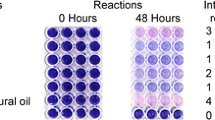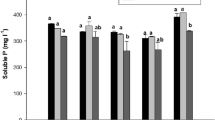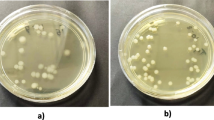Abstract
Liquid microbial inoculants have recently received great attention due to their vital roles for sustainable agricultural practices. However, long-term conservation under ambient temperature conditions and deleterious environmental factors might negatively impact microbial cell survival and limit their efficacy in the field. Thus, developing efficient liquid formulation providing prolonged survival of rhizobia in the final product and after an application is crucial. Therefore, this study investigates the effect of various additives on the long-term survival of rhizobia stored in liquid cultures at room temperature (25 °C) for 12 months. Various yeast sucrose media amended with polyvinylpyrrolidone (PVP) or gum arabic as colloidal agents in combination with ectoine (as a compatible solute) and/or glycerol were evaluated. A dramatic decline in viable cell count was obtained in formulas amended only with PVP from Log 8.5 to Log 5 in the first six months and then to Log 1.5 after 12 months. In contrast, rhizobia stored at PVP-based formulas amended with 10 mg L‒1 ectoine exhibited almost constant survival level till the end of the storage period. The same trend was obtained using formulas based on gum arabic as a colloidal dispersing agent; however, less decline in cell count using a formula containing gum arabic alone as compared to using PVP. On the other hand, PVP based formulas exhibited higher viscosity compared with another formula. Increased viscosity till the 8th month of storage was achieved in the presence of ectoine indicating the increase of exopolymeric substances production. Electrophoretic protein pattern of rhizobial cells (stored for 12 months) exhibited several low molecular weight protein bands in cells stored in PVP based formula with ectoine as compared to the other treatments. Thus, the amendment of the liquid formulation of rhizobia bioinoculant with PVP plus ectoine not only improved cell survival but also enhanced the culture viscosity and consequently ameliorate the colonization and performance of rhizobial inoculants.
Graphic Abstract


Similar content being viewed by others
Data Availability
The datasets used and/or analyzed during the current study are available from the corresponding authors on reasonable request.
References
FAO (1991) Report of expert consultation on legume inoculantproduction and quality control. FAO, Rome, p 148
Somasegaran P, Hoben JH (1994) Hand book for rhizobia, methods in legume-rhizobium technology. Springer, NewYork . https://doi.org/10.1007/978-1-4613-8375-8
Kumaresan G, Reetha D (2011) Survival of Azospirillum brasilense in liquid formulation amended with different chemical additives. J Phytol 3(10):48–51
Mahdi SS, Hassan GI, Samoon SA, Rather HA, Dar SA, Zehra B (2010) Biofertilizers in organic agriculture. J Phytol 2:42–54
Deaker R, Roughley RJ, Kennedy IR (2004) Legume seedinoculation technology—a review. Soil Biol Biochem 36:1275–1288. https://doi.org/10.1016/j.soilbio.2004.04.009
Paau AS (1989) Formulations usiful in applying beneficial microorganisms to seeds. Trends Biotechnol 6:276–279
Dayamani KJ, Brahmaprakash GP (2014) Influence of form and concentration of the osmolytes in liquid inoculants formulations of plant growth promoting bacteria. Int J Sci Res Publ 4:7
Zaccai G, Bagyan I, Combet J, Cuello GJ, Deme B, Fichou Y, Gallat FX, Galvan Josa VM, Von Gronau S, Haertlein M et al (2016) Neutrons describe ectoine effects on water H-bonding and hydration around a soluble protein and a cell membrane. Sci Rep 6:31434
Pastor JM, Salvador M, Argandona M, Bernal V, Reina-bueno M, Csonka BLN, Iborra JL, Vargas C, Nieto JJ, Canovas M (2010) Ectoines in cell stress protection: uses and biotechnological production. Biotechnol Adv 28:782–801. https://doi.org/10.1016/j.biotechadv.2010.06.005
Kunte HJ, Lentzen G, Galinski E (2014) Industrial production of the cell protectant ectoine: protection, mechanisms, processes, and products. Curr Biotechnol 3:10–25. https://doi.org/10.2174/22115501113026660037
Gouesbet G, Trautwetter A, Bonnassie S, Wu LF, Blanco C (1996) Characterization of the Erwinia chrysanthemi osmoprotectant transporter geneous A. J Bacteriol 178:447–455. https://doi.org/10.1128/jb.178.2.447-455
Jebbar M, Talibart R, Gloux K, Bernard T, Blanco C (1992) Osmoprotection of Escherichia coli by ectoine: uptake and accumulation characteristics. J Bacteriol 174:5027–5035. https://doi.org/10.1128/jb.174.15.5027-5035
Talibart R, Jebbar M, Gouesbet G, Himdi-kabbab S, Wroblewski H, Blanco C, Bernard T (1993) Osmoadaptation in Rhizobia: ectoine-induced salt tolerance. J Bacteriol 176(17):5210–5217
Kuhlmann AU, Bursy J, Gimpel S, Hoffmann T, Bremer E (2008) Synthesis of the compatible solute ectoine in Virgibacillus pantothenticus is triggered by high salinity and low growth temperature. Appl Environ Microbiol 74:4560–4563. https://doi.org/10.1128/AEM.00492-08
Roberts MF (2005) Organic compatible solutes of halotolerant and halophilic microorganism. Saline Syst 1(5):1746–1448. https://doi.org/10.1186/1746-1448-1-5
Vargas C, Argandona M, Reina-bueno M, Rodríguez-moya J, Fernández-aunión C, Nieto JJ (2008) Unravelling the adaptation responses to osmotic and temperature stress in Chromohalobacter salexigens, a bacterium with broad salinity tolerance. Saline Syst 4(1):14. https://doi.org/10.1186/1746-1448-4-14
Van-thuoc D, Guzmán H, Quillaguamán J, Hatti-kaul R (2010) High productivity of ectoines by Halomonas boliviensis using a combined two-step fed-batch culture and milking process. J Biotechnol 147(46):51. https://doi.org/10.1016/j.jbiotec.2010.03.003
Louis P, Trüper HG, Galinski EA (1994) Survival of Escherichia coli during drying and storage in the presence of compatible solutes. Appl Microbiol Biotechnol 41:684–688. https://doi.org/10.1007/BF00167285
Singleton PW, Keyser HH, Sande ES (2002) Development andevaluation of liquid inoculants. In: Herridge D (ed) Inoculants and nitrogenfixation of legumes in Vietnam ACIAR proceedings, vol 109, pp 52–66
Tittabutr P, Payakapong W, Teaumroong N, Singleton PW, Boonkerd N (2007) Growth, survival and field performance of bradyrhizobial liquid inoculant formulations with polymeric additives. Sci Asia 33:69–77
Sehgal SN, Gibbons NE (1960) Effect of metal ions on the growth of Halobacter iumcutirubrum. Can J Microbiol 5:165–169. https://doi.org/10.1139/m60-018
Zhang LH, Lang YJ, Nagata S (2009) Efficient production of ectoine using ectoine-excreting strain. Extremophiles 13:717–724. https://doi.org/10.1007/s00792-009-0262-2
Husseiny SM, Sheref FA, Amer HA, Elsakhawy TA (2015) Biosynthesis of applicable levan by a new levan producing moderately halophilic strain Chromohalobacter salexigens TA1 and its biological activities. Curr Sci Int 4(423):434
Dubois M, Gillis KA, Hamilton JK, Rebers PA, Smith F (1956) Colorimetric method for determination of sugar and related substance. Anal Chem 28:350–356. https://doi.org/10.1021/ac60111a017
Laemmli UK (1970) Cleavage of structural proteins during the assembly of the Lowry method for protein determination. Anal Biochem 155:243–248
Arndt C, Koristka S, Feldmann A, Bartsch H, Bachmann M (2012) Coomassie-brilliant blue staining of polyacrylamide gels. Protein Electrophoresis. https://doi.org/10.1007/978-1-61779-821-4_40
Bushby HVA, Marshall KC (1977) Some factors affecting the survival of root-nodule bacteria on desiccation. Soil Biol Biochem 9:143–147. https://doi.org/10.1016/0038-0717(77)90065-7
Mishustin EN, Shil’nikova VK (1968) Biological fixation of atmospheric nitrogen. Pennsylvania State University Press, London
Mugnier J, Jung G (1985) Survival of bacteria and fungi in relation to water activity and the solvent properties of water inbiopolymer gels. Appl Environ Microbiol 50:108–114
Perroud B, Lerudulier D (1985) Glycine betaine transport in Escherichia coli: osmotic modulation. J Bacteriol 161:393–401
Costerton JW (1985) The role of bacterial exopolysaccharides in nature and disease. Dev Ind Microbiol 26:249–269
Costerton JW, Irvin RT (1981) The bacterial glycocalyx in nature and disease. Annu Rev Microbiol 35:299–324
Errington JR, Pablo GD, Brian AP (2002) The stability of proteinsin a polyvinyl pyrrollidone matrix, Department of chemical engineer. Princeton University, Princeton
Zhang L, Lang Y, Wang C, Nagata S (2008) Promoting effect of compatible solute ectoine on the ethanol fermentation by Zymomonas mobilis CICC10232. Process Biochem 43:642–646. https://doi.org/10.1016/j.procbio.2008.02.003
Lorda B (1996) Designing media I and II. In: Ballatti and Freire (ed), Legume inoculants. selection and characterization of strains, production, use and management. Editorial Kingraf, Buenos Aires, p 148.
Girisha HC, Brahamprakash GP, Mallesha BC (2006) Effect of osmo protectant (PVP-40) on survival of Rhizobiumin different inoculants formulation and nitrogen fixation in cowpea. Geobios 33:151–156. https://doi.org/10.18535/ijsrm/v6i3.b02
Fetyan NA, Mansour AA (2012) Molecular, Biochemical and Physiological characterization of symbiotic bacteria isolated from saline soil in Saudi Arabia. Aust J Basic Appl Sci 6(3):229–239
Acknowledgements
This work was supported by the Agricultural Research Center, Egypt. The authors highly acknowledge the staff members of Microbiology Department, Sakha Agricultural Research Station for their support.
Funding
None.
Author information
Authors and Affiliations
Contributions
All authors contributed to experimental design, laboratory work, data analysis, drafting or revising the article, gave final approval of the version to be published, and agree to be accountable for all aspects of the work.
Corresponding author
Ethics declarations
Conflict of interest
The authors declare that they have no competing interests.
Additional information
Publisher's Note
Springer Nature remains neutral with regard to jurisdictional claims in published maps and institutional affiliations.
Rights and permissions
About this article
Cite this article
Elsakhawy, T., Ghazi, A. & Abdel-Rahman, M.A. Developing Liquid Rhizobium Inoculants with Enhanced Long-Term Survival, Storage Stability, and Plant Growth Promotion Using Ectoine Additive. Curr Microbiol 78, 282–291 (2021). https://doi.org/10.1007/s00284-020-02265-z
Received:
Accepted:
Published:
Issue Date:
DOI: https://doi.org/10.1007/s00284-020-02265-z




